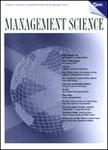-
作者:Meade, N; Islam, T
作者单位:Imperial College London
摘要:The paper identifies 29 models that the Literature suggests are appropriate for technological forecasting. These models are divided into three classes according to the timing of the point of inflexion in the innovation or substitution process. Faced with a given data set and such a choice, the issue of model selection needs to be addressed. Evidence used to aid model selection is drawn from measures of model fit and model stability. An analysis of the forecasting performance of these models us...
-
作者:Nutt, PC
作者单位:University System of Ohio; Ohio State University
摘要:The evaluation of alternatives during organizational decision making was investigated to uncover evaluation tactics used by decision makers and how these tactics and complexity influenced success. Evaluation tactics that relied upon subjective, judgmental, bargaining, and analytical inferences were uncovered from 317 strategic decisions. The complexity of these decisions was measured by the numbers of alternatives considered, number of criteria used, and perceived difficulty of the evaluation ...
-
作者:Cooper, RB; Niu, SC; Srinivasan, MM
作者单位:State University System of Florida; Florida Atlantic University; University of Texas System; University of Texas Dallas; University of Tennessee System; University of Tennessee Knoxville
摘要:Sarkar and Zangwill (1991) showed by numerical examples that reduction in setup times can, surprisingly, actually increase work in process in some cyclic production systems (that is, reduction in switchover times can increase waiting times in some polling models). We present, for polling models with exhaustive and gated service disciplines, some explicit formulas that provide additional insight and characterization of this anomaly. More specifically, we show that, for both of these models, the...
-
作者:Kulatilaka, N; Perotti, EC
作者单位:Boston University; University of Amsterdam
摘要:We provide a strategic rationale for growth options under uncertainty and imperfect competition. In a market with strategic competition, investment confers a greater capability to take advantage of future growth opportunities. This strategic advantage leads to the capture of a greater share of the market, either by dissuading entry or by inducing competitors to make room for the stronger competitor. As a result of this strategic effect, payoffs are in a rough sense more convex than in the case...

